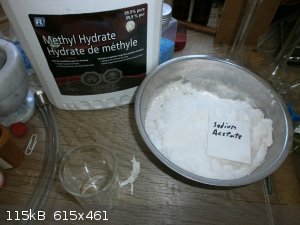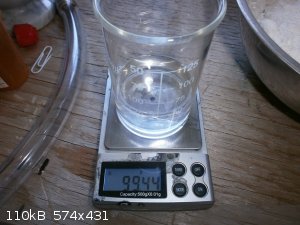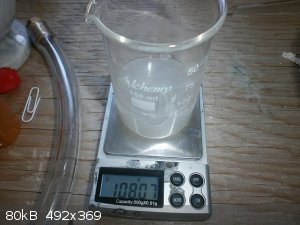G-Coupled
Hazard to Others
  
Posts: 287
Registered: 9-3-2017
Member Is Offline
Mood: Slightly triturated
|
|
Sodium Acetate-'Hot Ice'-What Could I Have Made?
Hello everyone.
I wanted to have some Sodium Acetate around as it might be a useful chemical to have for some experiments I might want to perform, so decided to make
it using the 'Make Hot Ice At Home!' instructions that are all over the 'net.
I used some 'distilled white vinegar', some Sodium Carbonate powder/small crystals (Washing Soda) and water, followed the instructions by adding
roughly equimolar amounts and gently simmering it down until the 'skin' was just about forming on top.
When I tried to do the 'hot ice' demonstration by introducing some crystals of what I'd produced to the supersaturated solution, I couldn't get it to
work at all.
I ended up by gently evaporating the solution down until I was left with a pan of off-white powder which I then dried in the oven on a wide Pyrex dish
(to try and make anhydrous SA) which I then stored in a pickling jar.
I read that one can test for Sodium Acetate by 'Heat the Sodium Acetate gradually. It fuses, then decomposes, and an odour of acetone is evolved.'
I did this, and the powder just sat there on the spoon, which was getting really hot, and some of the powder just blackened, looking like it had
carbonised or similar, and certainly no 'odour of acetone' was evident.
What could I have made following that procedure using those products that could act like that if it's not Sodium Acetate?
Thanks for any help!
[Edited on 27-7-2017 by G-Coupled]
|
|
|
XeonTheMGPony
International Hazard
    
Posts: 1636
Registered: 5-1-2016
Member Is Offline
Mood: No Mood
|
|
Probably heavy contaminated with the carbonate
Use the strongest viniger solution you can find, then add carbonate slowly till the fizzing dies down but doesn't stop (excess viniger)
Now simmer slowly with lots of windows open (We're now driving off the water and viniger) evaporate till it readily skins
The test with the spoon is the same only it is Acetic acid (Super pungent viniger not acetone you'll smell)
let cool then after cool agitate it should form a slurry of crystals
Opt 2:
Can you preform distillations? If so look into the Ethyle acetate sodium hydroxide method, bonus is fairly pure ethanol you can use as a solvent! or
fuel how ever DO NOT DRINK!!!!
[Edited on 27-7-2017 by XeonTheMGPony]
|
|
|
G-Coupled
Hazard to Others
  
Posts: 287
Registered: 9-3-2017
Member Is Offline
Mood: Slightly triturated
|
|
Thanks for the quick reply!
Do you mean it could be 'heavy metal' contaminated Sodium Carbonate?
It was sold as 'Washing Soda', but it is in the form of nice, very white, evenly-sized small granules.
|
|
|
A Halogenated Substance
Hazard to Self
 
Posts: 68
Registered: 7-2-2017
Location: United States
Member Is Offline
Mood: Oxidizing due to extended exposure to oxygen
|
|
Not "heavy metal" contaminated but just heavily contaminated with sodium carbonate. The granules you described seems to be, in my experience, a very
common way for commercial sellers to sell sodium carbonate.
You may have to start over as ridding the contaminants from your first attempt could be tricky. You could add an acid to rid of the carbonate but then
you'd just be left with whatever salt that resulted from the reaction contaminating your sodium acetate.
I would personally start over again and use the layout that XeonTheMGPony wrote above.
If you really wanted to reuse your sample, you could re-acidify it to get acetic acid and a sodium salt. Then if you have the equipment, distill over
your acetic acid and then proceed from there without hassling with more dilute cleaning vinegar.
|
|
|
G-Coupled
Hazard to Others
  
Posts: 287
Registered: 9-3-2017
Member Is Offline
Mood: Slightly triturated
|
|
Sorry - I'm being a bit dense here - you're saying that you think that my product could be contaminated with unreacted Sodium Carbonate? I did think
this, but the dry powder shows no sign of reacting with vinegar or Acetic Acid, so I presumed that there wasn't any unreacted SC present.
|
|
|
Loptr
International Hazard
    
Posts: 1347
Registered: 20-5-2014
Location: USA
Member Is Offline
Mood: Grateful
|
|
Try adding some (small test amount) of this powder to water in a test tube and letting it dissolve, and then adding a drop of
concentrated HCl to the solution. If you see effervescence with the release of CO2(g), then you still have a bit of NaCO3 in the mixture.
I would then make a solution from the rest of the powder in water, and while testing the pH of the solution, slowly add drops of acetic acid (vinegar)
until the pH shows a slightly acidic solution. This means that you will have a slight excess of acetic acid, and should be able to evaporate to
dryness without issue.
"Question everything generally thought to be obvious." - Dieter Rams
|
|
|
G-Coupled
Hazard to Others
  
Posts: 287
Registered: 9-3-2017
Member Is Offline
Mood: Slightly triturated
|
|
Quote: Originally posted by Loptr  | | Try adding some (small test amount) of this powder to water in a test tube and letting it dissolve, and then adding a drop of
concentrated HCl to the solution. If you see effervescence with the release of CO2(g), then you still have a bit of NaCO3 in the mixture.
|
Aha! This I did, and it did indeed effervesce, which it didn't do when I tried it with simple vinegar (I didn't have any Glacial Acetic Acid at the
time).
Thanks for your answers, everyone! 
|
|
|
XeonTheMGPony
International Hazard
    
Posts: 1636
Registered: 5-1-2016
Member Is Offline
Mood: No Mood
|
|
As stated above!
Starting with Carbonate reacts with less bubbling, so it is easy to add too much by accident, so go on the error of excess viniger, then when boiling
it down you will ensure all the carbonate been reacted fully, then on recrystallizing any excess acetic acid will be removed leaving you with very
pure Sodium acetate.
I ran into this very issue when making sodium acetate for my glacial acetic acid synth.
I then switched to the 2nd option as I needed ethanol for other work ups so I bought several things of acetone free nail polish remover (Bulk of it is
ethyle acetate) Distilled it twice for good purity, then re-fluxed with sodium hydroxide, then recrystallized, this yielded a great deal of my target
compounds.
If you can't do my 2nd option you could gently evaporate down the viniger solution to concentrate it then start over, aim for excess viniger though as
this is the easiest to remove from your final product.
I did it by smell, if I couldn't smell strong viniger scent I added more till I could so my limiting reagent was the sodium carbonate.
|
|
|
G-Coupled
Hazard to Others
  
Posts: 287
Registered: 9-3-2017
Member Is Offline
Mood: Slightly triturated
|
|
So, essentially, I'll be OK dissolving the powder in a pan of as little water as it takes, and then add distilled vinegar until slightly in excess and
then gently boil down as how I made it in the 1st place?
|
|
|
Loptr
International Hazard
    
Posts: 1347
Registered: 20-5-2014
Location: USA
Member Is Offline
Mood: Grateful
|
|
That sounds like a reasonable approach. It would help to keep the water at the minimum level needed to dissolve the material.
It can be recrystallized from EtOH and should precipitate as the trihydrate.
Here is a blog of a student (I assume?) and his experiences with a sodium acetate lab involving recrystallization and preparing a supersaturated
solution for the hot ice experiment.
http://www.chemistry-blog.com/2009/02/10/chemistry-lab-demon...
"Question everything generally thought to be obvious." - Dieter Rams
|
|
|
G-Coupled
Hazard to Others
  
Posts: 287
Registered: 9-3-2017
Member Is Offline
Mood: Slightly triturated
|
|
Would Methanol work just as well? (I don't have EtOH, unfortunately)
|
|
|
XeonTheMGPony
International Hazard
    
Posts: 1636
Registered: 5-1-2016
Member Is Offline
Mood: No Mood
|
|
Buy some vodka?
I'll test for you tonight as I have both methanol hydrate and dry sodium acetate laying around at home!
Actually yes it does work! that's how I cleaned up the acetate I used to make glacial! but hold off till I retest.
[Edited on 27-7-2017 by XeonTheMGPony]
|
|
|
G-Coupled
Hazard to Others
  
Posts: 287
Registered: 9-3-2017
Member Is Offline
Mood: Slightly triturated
|
|
Thank you!
|
|
|
XeonTheMGPony
International Hazard
    
Posts: 1636
Registered: 5-1-2016
Member Is Offline
Mood: No Mood
|
|
CONFIRMED!
50Ml of methanol hydrate dissolved 9grams at 20c to saturated condition.
So with heating it should dissolve much more! but for filtration purposes you want to avoid a super saturated solution! providing filtering is
needed.
I'd recommend filtering through a cotton ball lightly pressed in a funnel as it will remove most of the gunk with ease.
[Edited on 28-7-2017 by XeonTheMGPony]
  
|
|
|
G-Coupled
Hazard to Others
  
Posts: 287
Registered: 9-3-2017
Member Is Offline
Mood: Slightly triturated
|
|
Thank you ever so much!
I will report back with my results. 
|
|
|
XeonTheMGPony
International Hazard
    
Posts: 1636
Registered: 5-1-2016
Member Is Offline
Mood: No Mood
|
|
Just a pointer, the methanol is a bear to drive out of the purified acetate, you'll want to boil off as much methanol as possible then while a trace
remains take it out and put it in a oven safe glass dish then micro wave it to dryness.
the dish should be 2 to 3 times the size required to hold it as it will expand and although a microwave should be the safest method use an old one
placed away from any thing flammable.
And when boiling down the methanol USE MAX VENTILATION methanol is a poison, it will absorb through the lungs!
|
|
|